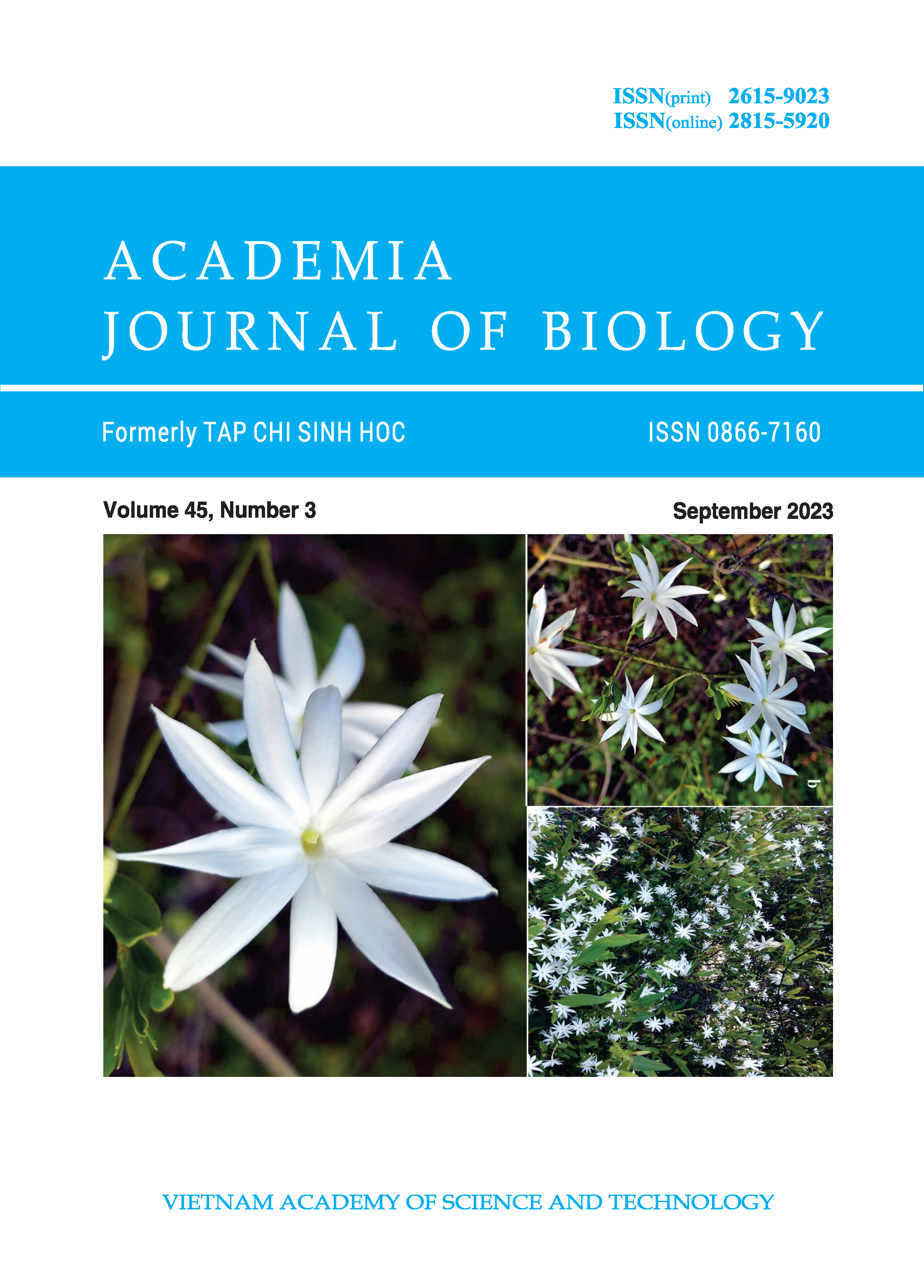Producing a recombinant vector that carries the vascular class III peroxidase (\(\textit{PRX1}\)) gene from \(\textit{Catharanthus roseus}\)
Authors
DOI: https://doi.org/10.15625/2615-9023/18664Keywords:
Anticancer drugs, Catharanthus roseus, PRX1, recombinant plasmid, vinblastine, vincristine.References
Balandrin M. F., Klocke J. A., 1988. Biotechnology in Agriculture and Forestry, Medicinal, Aromatic, and Industrial Materials from Plants. Berlin, Heidelberg: Springer Berlin Heidelberg, pp. 3–36.
Caputi L., Franke J., Farrow S. C., Chung K., Payne R. M. E., Nguyen T. D., Dang T. T. T., Soares Teto Carqueijeiro I., Koudounas K., Dugé de Bernonville T., Ameyaw B., Jones D. M., Vieira I. J. C., Courdavault V., O’Connor S. E., 2018. Missing enzymes in the biosynthesis of the anticancer drug vinblastine in Madagascar periwinkle. Science, 360(6394): 1235–1239. https://doi.org/10.1126/science.aat4100
Costa M. M. R., Hilliou F., Duarte P., Pereira L. G., Almeida I., Leech M., Memelink J., Barceló A. R., Sottomayor M., 2008. Molecular Cloning and Characterization of a Vacuolar Class III Peroxidase Involved in the Metabolism of Anticancer Alkaloids in Catharanthus roseus. Plant Physiology, 146(2): 403–417. https://doi.org/10.1104/pp.107.107060
Gustafsson C., Govindarajan S., Minshull J., 2004. Codon bias and heterologous protein expression. Trends in Biotechnology, 22(7): 346–353. https://doi.org/10.1016/j.tibtech.2004.04.006
John Jumper, Richard Evans, Alexander Pritzel, Tim Green, Michael Figurnov, Olaf Ronneberger, Kathryn Tunyasuvunakool, Russ Bates, Augustin Žídek, Anna Potapenko, Alex Bridgland, Clemens Meyer, Simon A. A. Kohl, Andrew J. Ballard, Andrew Cowie, Bernardino Romera-Paredes, Stanislav Nikolov, Rishub Jain, Jonas Adler, Trevor Back, Stig Petersen, David Reiman, Ellen Clancy, Michal Zielinski, Martin Steinegger, Michalina Pacholska, Tamas Berghammer, Sebastian Bodenstein, David Silver, Oriol Vinyals, Andrew W. Senior, Koray Kavukcuoglu, Pushmeet Kohli, and Demis Hassabis., 2021. Highly accurate protein structure prediction with AlphaFold. Nature, 596(7873): 583−589. https://doi.org/10.1038/s41586-021-03819-2
Kharwar R. N., Verma V. C., Strobel G., Ezra D., 2008. The endophytic fungal complex of Catharanthus roseus (L.) G. Don. Current Science.
Kumar A., Patil D., Rajamohanan P. R., Ahmad A., 2013. Isolation, Purification and Characterization of Vinblastine and Vincristine from Endophytic Fungus Fusarium oxysporum Isolated from Catharanthus roseus. PLoS ONE, 8(9): e71805. https://doi.org/10.1371/journal.pone.0071805
Kuriakose G. C., Palem P. P. C., Jayabaskaran C., 2016. Fungal vincristine from Eutypella spp - CrP14 isolated from Catharanthus roseus induces apoptosis in human squamous carcinoma cell line -A431. BMC Complementary and Alternative Medicine, 16(1): 302. https://doi.org/10.1186/s12906-016-1299-2
Kusari S., Hertweck C., Spiteller M., 2012. Chemical Ecology of Endophytic Fungi: Origins of Secondary Metabolites. Chemistry & Biology, 19(7): 792–798. https://doi.org/10.1016/j.chembiol.2012.06.004
Lay C. S., Agustina I., Astuti P., Hertiani T., 2023. Cytotoxic screening of endophytic fungi associated with Catharanthus roseus. Biodiversitas Journal of Biological Diversity, 24(5): 2716–2722. https://doi.org/10.13057/biodiv/d240525
McGrogan B. T., Gilmartin B., Carney D. N., McCann A., 2008. Taxanes, microtubules and chemoresistant breast cancer. Biochimica et Biophysica Acta (BBA) - Reviews on Cancer, 1785(2): 96–132. https://doi.org/10.1016/j.bbcan.2007.10.004
Palem P. P. C., Kuriakose G. C., Jayabaskaran C., 2015. An Endophytic Fungus, Talaromyces radicus, Isolated from Catharanthus roseus, Produces Vincristine and Vinblastine, Which Induce Apoptotic Cell Death. PLoS ONE, 10(12): e0144476. https://doi.org/10.1371/journal.pone.0144476
Pandey S. S., Singh S., Babu C. S. V., Shanker K., Srivastava N. K., Shukla A. K., Kalra, A., 2016. Fungal endophytes of Catharanthus roseus enhance vindoline content by modulating structural and regulatory genes related to terpenoid indole alkaloid biosynthesis. Scientific Reports, 6(1): 26583. https://doi.org/10.1038/srep26583
Plotkin J. B., Kudla G., 2011. Synonymous but not the same: the causes and consequences of codon bias. Nature Reviews Genetics, 12(1): 32–42. https://doi.org/10.1038/nrg2899
Sottomayor M., Duarte P., Figueiredo R., Barceló A. R., 2008. A vacuolar class III peroxidase and the metabolism of anticancer indole alkaloids in Catharanthus roseus. Plant Signaling & Behavior, 3(10): 899–901. https://doi.org/10.4161/psb.3.10.6576
Tanaka M., Tokuoka M., Gomi K., 2014. Effects of codon optimization on the mRNA levels of heterologous genes in filamentous fungi. Applied Microbiology and Biotechnology, 98(9): 3859–3867. https://doi.org/10.1007/s00253-014-5609-7
Tanaka M., Tokuoka M., Shintani T., Gomi K., 2012. Transcripts of a heterologous gene encoding mite allergen Der f 7 are stabilized by codon optimization in Aspergillus oryzae. Applied Microbiology and Biotechnology, 96(5): 1275–1282. https://doi.org/10.1007/s00253-012-4169-y
Tokuoka M., Tanaka M., Ono K., Takagi S., Shintani T., Gomi K., 2008. Codon Optimization Increases Steady-State mRNA Levels in Aspergillus oryzae Heterologous Gene Expression. Applied and Environmental Microbiology, 74(21): 6538–6546. doi: 10.1128/aem.01354-08
Tran Thi Huong Giang, Nguyen Duc Quan, Duong Anh Linh, Nguyen Ngoc Lan, Le Quang Huy, Nguyen Thi Kim Lien, Nguyen Huy Hoang, 2021. Isolation and identification of endophytic fungi from Catharanthus roseus and Scutallaria barbata. Academia Journal of Biology, 43(2): 1–10. https://doi.org/10.15625/2615-9023/15920
Waterhouse A., Bertoni M., Bienert S., Studer G., Tauriello G., Gumienny R., Heer F.T., de Beer T.A.P., Rempfer C., Bordoli L., Lepore R., Schwede T., 2018. SWISS-MODEL: homology modelling of protein structures and complexes. Nucleic Acids Res. 46:296-303. https://doi.org/10.1093/nar/gky427
Welinder K. G., 1992. Superfamily of plant, fungal and bacterial peroxidases. Current Opinion in Structural Biology, 2(3): 388–393. https://doi.org/10.1016/0959-440X(92)90230-5
Downloads
Metrics
Downloads
PDF Downloaded: 85
Published
How to Cite
Issue
Section
License
Copyright (c) 2023 Cao Thi Thu Thuy, Nguyen Thi Bich Ngoc, Nguyen Duc Quan, Le Tat Thanh, Nguyen Huy Hoang, Huynh Thi Thu Hue

This work is licensed under a Creative Commons Attribution-ShareAlike 4.0 International License.





